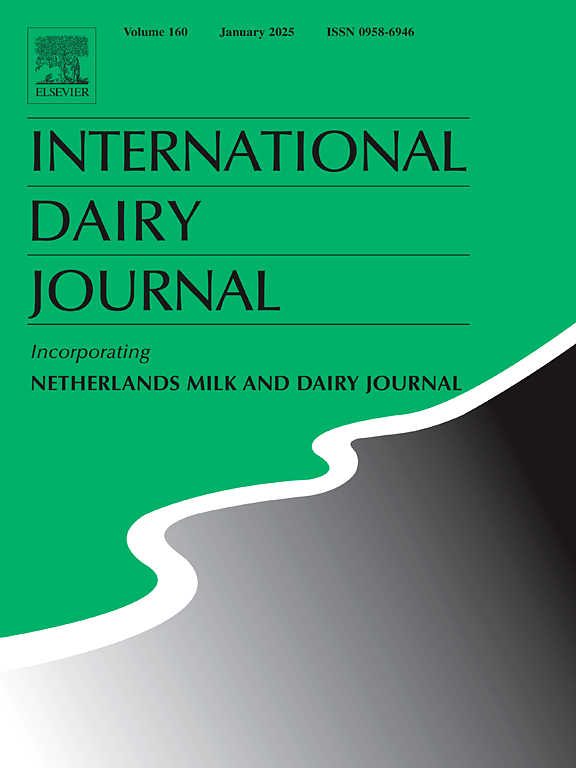Effects of homogenization and heat treatment on camel milk: Physicochemical properties, microstructure, and digestibility in infants
IF 3.1
3区 农林科学
Q2 FOOD SCIENCE & TECHNOLOGY
引用次数: 0
Abstract
Milk is typically processed through homogenization and heat treatment, which alter its physicochemical properties and digestibility. This study investigated the effects of homogenization and heat treatment on the microstructure and functional characteristics of camel milk. The fatty acid profiles of camel milk as well as the sequences, protein origins, and bioactivities of different peptides derived from camel milk were compared after different treatments through an in-vitro simulation of the infant gastrointestinal tract. Homogenization and appropriate heat treatment enhanced the protein interface properties of camel milk and also reduced its zeta potential, particle size, and protein and lipid aggregation after digestion, leading to improved stability and digestibility. Furthermore, homogenization and ultra-high temperature (UHT) treatment led to significant changes in the fatty acid profile during the digestion stage, decreasing the saturated fatty acid content by 7.67% while increasing the unsaturated fatty acid content (i.e., C17:1, C18:1n9t, C18:1n9c, C18:2n6c, C20:1, C20:3n6, C22:1, and C24:1). Heat treatment facilitated the release of digestive peptides, most of which were derived from β-casein. UHT-treated camel milk yielded several specific peptides during digestion, of which LLFR, IQDAQDKLFLSWVEWKR, FLK, and GSLDEFFHR showed a range of biological activities, including antimicrobial, antihypertensive, and neuromodulatory effects. These bioactive peptides demonstrated the potential to synergistically promote the development of a robust gut microbiome in infants and enhance immunity, effectively preventing disease occurrence. Collectively, the findings indicated that homogenized and UHT-treated camel milk is easily digested and absorbed by infants and provides more nutrients, thereby promoting infant growth and development.
均质化和热处理对骆驼奶的影响:理化性质、微观结构和婴儿消化率
牛奶通常是通过均质化和热处理来加工的,这改变了它的物理化学性质和消化性。本研究研究了均质和热处理对骆驼奶微观结构和功能特性的影响。通过体外模拟婴儿胃肠道,比较了不同处理后的骆驼奶脂肪酸谱,以及骆驼奶中不同多肽的序列、蛋白质来源和生物活性。均质化和适当的热处理增强了骆驼奶的蛋白质界面特性,降低了骆驼奶的zeta电位、颗粒大小以及消化后的蛋白质和脂肪聚集,从而提高了骆驼奶的稳定性和消化率。此外,均质和超高温(UHT)处理导致消化阶段脂肪酸谱发生显著变化,饱和脂肪酸含量降低7.67%,不饱和脂肪酸含量升高(C17:1、C18:1n9t、C18:1n9c、C18:2n6c、C20:1、C20:3n6、C22:1和C24:1)。热处理促进了消化肽的释放,其中大部分来自β-酪蛋白。经uht处理的骆驼奶在消化过程中产生了几种特定的肽,其中LLFR、IQDAQDKLFLSWVEWKR、FLK和GSLDEFFHR显示出一系列的生物活性,包括抗菌、降压和神经调节作用。这些生物活性肽显示出协同促进婴儿肠道微生物群发育和增强免疫力的潜力,有效预防疾病发生。综上所述,均质和高温处理的骆驼奶更容易被婴儿消化和吸收,提供更多的营养,从而促进婴儿的生长发育。
本文章由计算机程序翻译,如有差异,请以英文原文为准。
求助全文
约1分钟内获得全文
求助全文
来源期刊

International Dairy Journal
工程技术-食品科技
CiteScore
6.50
自引率
9.70%
发文量
200
审稿时长
49 days
期刊介绍:
The International Dairy Journal publishes significant advancements in dairy science and technology in the form of research articles and critical reviews that are of relevance to the broader international dairy community. Within this scope, research on the science and technology of milk and dairy products and the nutritional and health aspects of dairy foods are included; the journal pays particular attention to applied research and its interface with the dairy industry.
The journal''s coverage includes the following, where directly applicable to dairy science and technology:
• Chemistry and physico-chemical properties of milk constituents
• Microbiology, food safety, enzymology, biotechnology
• Processing and engineering
• Emulsion science, food structure, and texture
• Raw material quality and effect on relevant products
• Flavour and off-flavour development
• Technological functionality and applications of dairy ingredients
• Sensory and consumer sciences
• Nutrition and substantiation of human health implications of milk components or dairy products
International Dairy Journal does not publish papers related to milk production, animal health and other aspects of on-farm milk production unless there is a clear relationship to dairy technology, human health or final product quality.
 求助内容:
求助内容: 应助结果提醒方式:
应助结果提醒方式:


